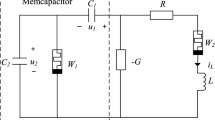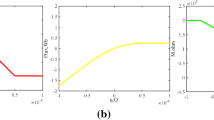Abstract
The development of traditional CMOS-based logic circuits in terms of speed and energy consumption is approaching the limit. Memristor is a kind of bio-inspired hardware with a special structure, which has the advantages of simple structure, low power consumption and easy integration. It has good application prospects in high performance memory and neural network. The invention of memristor provides a new way to develop a more efficient circuit design. In this paper, the second order damping system based on memristor is used to realize the function of human body perceptron. By taking advantage of the variable resistance of memristors, the function of real-time perception can be realized. The second order underdamped state itself is used to realize the sensory adaptation ability of perceptrons. Through theoretical analysis and Pspice simulation, the feasibility of the second order damped system perceptron based on memristor is verified. The human body sensor based on memristor provides a reference for more future intelligent robots. It also provides support for the development and application of bio-inspired hardware.
This work was supported in part by the National Key Research and Development Program of China for International S and T Cooperation Projects under Grant 2017YFE0103900, in part by the Joint Funds of the National Natural Science Foundation of China under Grant U1804262, in part by the State Key Program of National Natural Science of China under Grant 61632002, in part by the Foundation of Young Key Teachers from University of Henan Province under Grant 2018GGJS092, in part by the Youth Talent Lifting Project of Henan Province under Grant 2018HYTP016, in part by the Henan Province University Science and Technology Innovation Talent Support Plan under Grant 20HASTIT027, in part by the Zhongyuan Thousand Talents Program under Grant 204200510003.
Access this chapter
Tax calculation will be finalised at checkout
Purchases are for personal use only
Similar content being viewed by others
References
Jin, X., Su, T., Kong, J., Bai, Y., Miao, B., Dou, C.: State-of-the-art mobile intelligence. Enabling robots to move like humans by estimating mobility with artificial intelligence. Appl. Sci. 8(3), 1–39 (2018). Article no. 379
Cui, C., Bian, G., Hou, Z., Zhao, J., Zhou, H.: A multimodal framework based on integration of cortical and muscular activities for decoding human intentions about lower limb motions. IEEE Trans. Biomed. Circuits Syst. 11(4), 889–899 (2017)
Rasouli, M., Chen, Y., Basu, A., Kukreja, S.L., Thakor, N.V.: An extreme learning machine-based neuromorphic tactile sensing system for texture recognition. IEEE Trans. Biomed. Circuits Syst. 99(12), 313–325 (2018)
Navaraj, W.T., Nunez, C.G., Shakthivel, D., Vinciguerra, V., Labeau, F., Gregory, D.H., Dahiya, R.: Nanowire FET based neural element for robotic tactile sensing skin. Front. NeuroSci. 11, 501 (2017)
Kawasaki, H., Mouri, T.: Humanoid robot hand and its applied research. J. Robot. Mechatron. 31(1), 16–26 (2019)
Pflug, G.: Book review: the oxford dictionary of statistical terms. Biom. J. 46(2), 284 (2004)
Sebrechts, M.M.: The Psychology of Human-Computer Interaction (Book). Erlbaum Associates Inc., New Jersey (1983). American Entist
Bills, A.G.: Sensation and perception in the history of experimental psychology. Psychol. Bull. 40(3), 222–225 (1943)
APAFreeman, R.B.: The senses considered as perceptual systems. Q. Rev. Biol. 1, 8–9 (1969)
Belkaid, M., Cuperlier, N., Gaussier, P.: Emotional modulation of peripersonal space as a way to represent reachable and comfort areas. In: Intelligent Robots and Systems, pp. 353–359 (2015)
Ramirezamaro, K., Beetz, M., Cheng, G.: Understanding the intention of human activities through semantic perception: observation, understanding and execution on a humanoid robot. Adv. Robot. 29(5), 345–362 (2015)
Chao, L., Tao, J., Yang, M., Li, Y., Wen, Z.: Audio Visual Emotion Recognition with Temporal Alignment and Perception Attention (2016). \({\rm arXiv {: }~Computer~Vision~and~Pattern~Recognition}\)
Goldstein, B.E., Brockmole, J.: Sensation and Perception. Cengage Learning, Boston (2016)
Duan, S.K., Hu, X.F., Wang, L.D., Li, C.D.: Analog memristive memory with applications in audio signal processing. Sci. China Inform. Sci. 57(4), 1–15 (2013). https://doi.org/10.1007/s11432-013-4864-z
Kaboli, M., Cheng, G.: Robust tactile descriptors for discriminating objects from textural properties via artificial robotic skin. IEEE Trans. Robot. 34(4), 985–1003 (2018)
Gupta, S., Yogeswaran, N., Giacomozzi, F., Lorenzelli, L., Dahiya, R.: Flexible AlN coupled MOSFET device for touch sensing. In: IEEE SENSORS (2018)
Chua, L.O.: Memristor-the missing circuit element. IEEE Trans. Circuit Theory 18(5), 507–519 (1971)
Strukov, D.B., Snider, G.S., Stewart, D.R., Williams, R.S.: The missing memristor found. Nature 453(7191), 80–83 (2008)
Li, C., Hu, M., Li, Y., Jiang, H., Xia, Q.: Analogue signal and image processing with large memristor crossbars. Nat. Electron. 1(1), 52–59 (2018)
Lehtonen, E., Laiho, M.: Stateful implication logic with memristors. In: IEEE/ACM International Symposium on Nanoscale Architectures, pp. 33–36 (2009)
Xia, Q., et al.: Memristor-CMOS hybrid integrated circuits for reconfigurable logic. Nano Lett. 9(10), 3640–3645 (2009)
Borghetti, J., Snider, G.S., Kuekes, P.J., Yang, J.J., Stewart, D.R., Williams, R.S.: ‘Memristive’ switches enable ‘stateful’ logic operations via material implication. Nature 464(7290), 873–876 (2010)
Kvatinsky, S., Wald, N., Satat, G., Kolodny, A., Friedman, E.G.: MRL-memristor ratioed logic. In: International Workshop on Cellular Nanoscale Networks and Their Applications, IEEE (2012)
Guckert, L., Swartzlander, E.E.: MAD gates-memristor logic design using driver circuitry. IEEE Trans. Circuits Syst. II Express Briefs 64(2), 171–175 (2017)
Kim, K., Williams, R.S.: A family of stateful memristor gates for complete cascading logic. IEEE Trans.Circuits Syst. 66(11), 4348–4355 (2019)
Papandroulidakis, G., Serb, A., Khiat, A., Merrett, G.V., Prodromakis, T.: Practical implementation of memristor-based threshold logic gates. IEEE Trans. Circuits Syst. 66(8), 3041–3051 (2019)
Muthuswamy, B.: Implementing memristor based chaotic circuits. Int. J. Bifurc. Chaos Syst. 20(05), 1335–1350 (2010)
Sun, J., Zhao, X., Fang, J., Wang, Y.: Autonomous memristor chaotic systems of infinite chaotic attractors and circuitry realization. Nonlinear Dyn. 94(4), 2879–2887 (2018). https://doi.org/10.1007/s11071-018-4531-4
Sun, J., Han, G., Wang, Y., Zhang, H., Wu, L.: Hybrid memristor chaotic system. J. Nanoelectron. Optoelectron. 13(6), 812–818 (2018)
Xu, C., Dong, X., Jouppi, N. P., Xie, Y.: Design implications of memristor-based RRAM cross-point structures. In: 2011 Design, Automation and Test in Europe, pp. 1–6 (2011)
Ebong, I., Mazumder, P.: Self-controlled writing and erasing in a memristor crossbar memory. IEEE Trans. Nanotechnol. 10(6), 1454–1463 (2011)
Shaarawy, N., et al.: Design and analysis of 2T2M hybrid CMOS-Memristor based RRAM. Microelectron. J. 73, 75–85 (2018)
Dubey, S.K., Reddy, A., Patel, R., Abz, M., Srinivasulu, A., Islam, A.: Architecture of resistive RAM with write driver. Solid State Electron. Lett. 2, 10–22 (2020)
Yan, X., Zhao, J., Liu, S., Zhou, Z., Liu, Q., Chen, J.S., Liu, X.: Memristor with Ag-cluster-doped TiO2 films as artificial synapse for neuroinspired computing. Adv. Funct. Mater. 28(1), 1705320 (2018)
Yoon, J.H., et al.: A low-current and analog Memristor with Ru as mobile species. Adv. Mater. 32(9), 1904599 (2020)
Zhou, L., et al.: Tunable synaptic behavior realized in C3N composite based memristor. Nano Energy 58, 293–303 (2019)
Kvatinsky, S., Friedman, E.G., Kolodny, A., Weiser, U.C.: TEAM: threshold adaptive memristor model. IEEE Trans. Circuits Syst. 60(1), 211–221 (2013)
Biolek, D., Biolkova, V., Biolek, Z.: SPICE model of memristor with nonlinear dopant drift. Radioengineering 18(2), 210–214 (2009)
Xu, F., Zhang, J.Q., Huang, S.F., Zhang, J.S., Xie, S.Q., Wang, M.S.: A new nonlinear dopant kinetic model of memristor and its application. Indian Journal of Physics 93(6), 765–772 (2018). https://doi.org/10.1007/s12648-018-1330-1
Rziga, F.O., Mbarek, K., Ghedira, S., Besbes, K.: An efficient Verilog-A memristor model implementation: simulation and application. J. Comput. Electron. 18(3), 1055–1064 (2019). https://doi.org/10.1007/s10825-019-01357-9
Nigus, M., Priyadarshini, R., Mehra, R.M.: Stochastic and novel generic scalable window function-based deterministic memristor SPICE model comparison and implementation for synaptic circuit design. SN Appl. Sci. 2(1), 1–20 (2019). https://doi.org/10.1007/s42452-019-1888-z
Zhang, Y., Wang, X., Li, Y., Friedman, E.G.: Memristive model for synaptic circuits. IEEE Trans. Circuits Syst. II-Express Briefs 64(7), 767–771 (2017)
Author information
Authors and Affiliations
Corresponding author
Editor information
Editors and Affiliations
Rights and permissions
Copyright information
© 2021 Springer Nature Singapore Pte Ltd.
About this paper
Cite this paper
Xiao, X., Han, J., Chen, X., Sun, J. (2021). Perceptron Circuit Design of Second Order Damped System Based on Memristor. In: Pan, L., Pang, S., Song, T., Gong, F. (eds) Bio-Inspired Computing: Theories and Applications. BIC-TA 2020. Communications in Computer and Information Science, vol 1363. Springer, Singapore. https://doi.org/10.1007/978-981-16-1354-8_24
Download citation
DOI: https://doi.org/10.1007/978-981-16-1354-8_24
Published:
Publisher Name: Springer, Singapore
Print ISBN: 978-981-16-1353-1
Online ISBN: 978-981-16-1354-8
eBook Packages: Computer ScienceComputer Science (R0)




